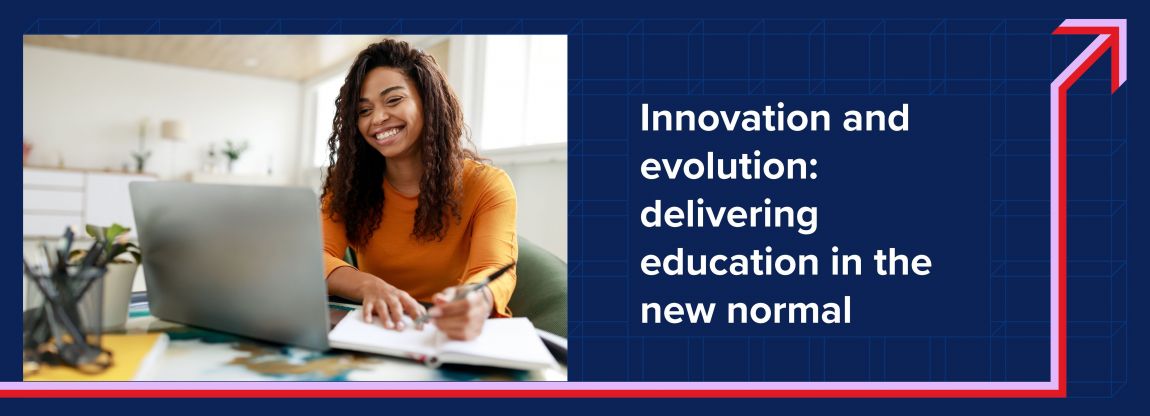Innovation and evolution: delivering education in the new normal
We were recently privileged to sponsor and attend the Chartered Association of Business School’s Learning, Teaching and Student Experience (LTSE) conference in Belfast. Bringing together some 350 members representing teaching and research staff, senior leadership and professional services, the meeting was characterised by a sense of unity and togetherness – felt both through the evident joy of colleagues at being able to meet and discuss face to face once more, and through stories of the challenges, opportunities and priorities shared across universities and business schools.
The theme of the opening plenary – innovation and evolution: delivering education in the new normal – was to be a major one across the conference – recognising that Higher Education is entering into a new era requiring new thinking, with a number of issues accelerated or thrust into the spotlight by the pandemic.
Balancing on-campus with on-screen


Most directly related to the events of the past 2 years is the issue of hybrid teaching and learning, with a full return to campus still an aspiration rather than a reality for many institutions, and stimulating discussion of the benefits and pitfalls of combining face to face with remote. For Jill Johnes, from Huddersfield Business School, the watch word is balance. It’s important, she believes, for leaders now to take a step back and think about the needs of different groups of students – under- and post-graduates, international and BTEC students, and those undertaking executive education – who cannot be treated a homogenous clump.
For example, executive learners like learning online but also appreciate face-to-face networking opportunities, while for international students there is often an actual requirement to attend in person. Even between year groups on an undergraduate course the preferences and requirements may differ. For technical subjects online lends itself very well to demo-ing and solving problems collaboratively, whereas for the social sciences there may be fewer substantive benefits to the online classroom. In short, there is no one size fits all; leaders must think about what the most appropriate blend of online and face-to-face might be to serve differing needs.
The question of the balance between on-campus and online has other dimensions of course. It’s not only about student needs and preferences but also those of staff, and the overarching pedagogical impact of remote-only learning. Les Henry, from University of Westminster London, talked about the imperative of fostering a sense of community among students both for wellbeing and engagement, with plenty of evidence that belonging is a key driver of student commitment and success. How well we are able to do this online (or not) is therefore critical, and Westminster has consciously made the decision to return to fully in-person learning.
Using technology to enhance an in-person experience
This point was very much supported by Paul Bartholomew, Vice Chair of Ulster University who highlights the distinction between learning and instruction. While the latter can be done online, he stresses the importance of co-location for learning as a social activity. This doesn’t mean that there is no place at all for technology but rather than it must be looked at in terms of how it augments and supports an in-person experience, with the strategy at Ulster resumed as ‘people, place and partnership.’
Yet getting students back on campus is another issue, with many instructors reporting a reluctance among learners to attend in person if there is a choice. Sally Everett, from King’s Business School talked about the disappointing take-up of the carefully designed induction programme of events for freshers this year. Students need convincing anew of the benefits of in-person learning.
At the same time, there is legitimate cause to look deeper into how technology can and should be used to maintain the opportunity for students to continue with at least blended learning, which – in spite of the government’s drive to get campuses fully open again – is something that students appear to want. We need to use research, she says, to drive strategy. The ‘Keep it Real’ campaign organised by students at King’s Student Union advocated for a return to in-person teaching and was successful in eliciting a public commitment from the university to return to levels of in-person contact consistent with pre-pandemic. But a separate survey of 1500 students revealed that 70% wanted a blended approach. Again, it perhaps comes back to balance. Sally is keen, however, that universities now invest properly in technology and move forward with improving digital learning as a part of the whole. “We’ve seen it work,” she says. “Now we need to be confident.”


Learning from lockdown
The idea of improving the use of technology in HE now that the initial rush and expediency of lockdown learning has passed is an important one. Les calls on leaders to ensure that staff are supported to design quality online courses that work, joking (but not joking) about students who now don’t want to come in because they were so put-off by boring online lectures during the pandemic. And it’s a two-way street; instructors can learn from what went well with remote teaching and learning to make in-person lectures more impactful. He believes that chalk and talk lectures don’t work anymore – at least in the social sciences – and that we can mimic elements of online learning on campus by breaking up learning with plenty of breaks, mixing up different tasks and approaches, working in smaller groups and coming back together for a plenary… some of the best students he has encountered now that UWE is back face-to-face are those who have had two years online because they have had the chance to get to know each other and get used to being interactive.


While there is no quick answer or magic bullet to the question of how much or how little universities should revert to in-person teaching now that the more alarming phase of the pandemic is behind us, what was evident from other sessions at LTSE and the conversations that we had with many instructors from across the UK was the weight that everyone was putting behind the question, and a willingness to explore and innovate in the name of pedagogical advancement. We were left with a sense that we are at a real turning point for Higher Education, not only in the integration of technology into learning, but also in terms of diversity and inclusion, sustainability, and meaningful assessment (although for the sake of readability, those topics will be the subject of future blogs).
Interested in how technology can augment your in-person teaching?
We’ve been working with a number of instructors in Ireland who have been using technology to great effect and seeing better student outcomes as a result. Discover more here.


